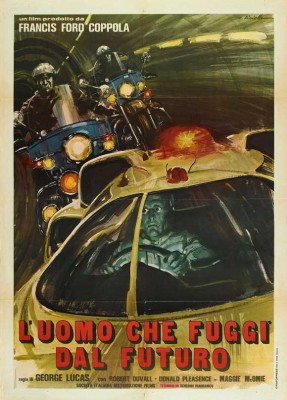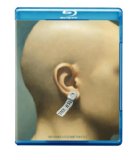| Reviews & Columns |
|
Reviews DVD TV on DVD Blu-ray 4K UHD International DVDs In Theaters Reviews by Studio Video Games Features Collector Series DVDs Easter Egg Database Interviews DVD Talk Radio Feature Articles Columns Anime Talk DVD Savant Horror DVDs The M.O.D. Squad Art House HD Talk Silent DVD
|
DVD Talk Forum |
|
|
| Resources |
|
DVD Price Search Customer Service #'s RCE Info Links |
|
Columns
|
|
|
THX 1138 (2004)
Watching the reworked THX, I thought back to May 24, 1977, the day before the first Star Wars film opened and took the world by storm, when George Lucas had three astonishingly good feature films to his credit, but the impact of his latest hadn't yet been felt. THX 1138, American Graffiti, and Star Wars couldn't be more different from one another, or from anything else that had been made up to that time. Each was revolutionary, explosively creative in myriad ways. Egregiously underrated among the many great directors that emerged in the late-1960s/early-'70s, George Lucas easily ranks alongside the very best. These three films were profoundly significant in my own burgeoning interest in cinema; in a sense, the personal impact of George Lucas is in no small way responsible for the very review you're reading now.
But since Star Wars, Lucas has become the film industry's Citizen Kane. Like Orson Welles's seminal character, the onetime antiestablishment Lucas at a relatively early age became wealthy beyond all reason, using his money and power to fashion for himself a multimedia empire, once hugely influential but now, while still an enormous cash cow, almost irrelevant. Like Kane Lucas has his own Xanadu, a veritable fortress up in Marin County, California where, apparently, he surrounds himself with "Yes Men" who never object to his bad taste. "It's no trick to make a lot of money. If all you want is to make a lot of money."
Lucas seems to think he is the sole owner-author of films he directed and even the Star Wars entries he did not. In the case of THX 1138, this claim is debatable. As far as I know, Warner Bros. owns the film outright. It was produced by Francis Ford Coppola and a co-production of his American Zoetrope company; contractually probably Coppola, not Lucas, had the right of final cut, as is standard in the industry.
And while there's no doubt Lucas is chiefly responsible for THX 1138 being what it is, what about the film's other key creative personnel? Co-writer and sound designer Walter Murch, music composer Lalo Schifrin, production designer Michael D. Haller, co-cinematographer David Myers, and actors like Robert Duvall? Did they sign off on Lucas's changes? Would they have made different choices given Lucas's changes?
But even if all that were possible - and it's not, because others who made major contributions died prior to 2004 - Lucas's proprietary attitude is still tragically misguided.
That's because movies are like children: a son or a daughter will always be your child, but once they reach a certain age or maturity they leave the nest and build lives of their own, lives that the parent can no longer - and should not - control. "Son, I know you've got a wife and kids but I want you to move back home so I can fix you up with someone else. You see, back in 1977 I wasn't making enough money down at the plant to be able to finish you off the way I would've liked." Once a movie goes into general release and becomes a shared experienced seen by millions of people, it's no longer the exclusive property of the filmmaker. Casablanca, The Wizard of Oz, Seven Samurai, A Matter of Life and Death: they belong to everyone.
By all accounts, Lucas is as insecure about his own accomplishments as he is stubbornly revisionist. Twenty-seven year-old George Lucas made a remarkable movie back in 1971, one that belied its low budget with incredibly imaginative concepts throughout, but 60-year-old George Lucas (as he was in 2004) sees only its flaws - flaws that in most cases aren't even there. Compounding this cinematic travesty is that Lucas doesn't even understand his own movie, not any more.
This reviewer saw Lucas's complete, original cut of the film in 35mm probably six or seven times during the 1970s and '80s (as well as once on a local TV station in Detroit, a jaw-dropping, one-shot airing that inexplicably left all the nudity and violence intact). Up to now, I hadn't seen the film in any form since the early-1990s, but even so Lucas's recognizable changes - and there are many that are imperceptible without comparing the two versions side-by-side (as is helpfully detailed at moviecensorship.com) - are clearly fundamentally ruinous.
The antiseptic, monochrome look of the film - almost a black and white movie with a great preponderance of the latter, which concludes with an indescribable burst of reddish violet in at the very end - is now infused with intrusive golds and other colorized shades, and expanded into something like 1984: The Epic as produced by Samuel Bronston. Roads eerily absent of automobiles in this totalitarian society, like the empty streets of downtown Pyongyang, are suddenly flush with CGI-created vehicles bustling at a wholly unbelievable, video-game speed, and in turn swallowed up in an almost inviting mega-metropolis resembling Coruscant from the (later) Star Wars movies. These images likewise subvert the original film's concept that everything was taking place underground, in cramped, claustrophobic fluorescent-lit white corridors and featureless cubicles.
Lucas also seems oblivious to the irony. A long time ago in a galaxy far, far away he had protested the colorization of classic black and white movies and fought for the preservation of old movies in their original form. But he thwarts that and more - lots more - here, even shooting new footage of massive, cataclysmic explosions at the robot factory where THX 1138 (Duvall) works, effectively ruining the tension of a more limited perspective of these same accidents, seen in the original from limited angles on television monitors and unnervingly described over the plant's intercom system. In the original you could barely tell, if at all, that THX was manufacturing robots, but in Lucas's new edition it's like an army of C-3POs.
Some of Lucas's creative choices are downright painful. Thudding literalness replaces ambiguity and subtlety. Yet more irony: the film's basic concept, of characters overwhelmed by technology risking their lives in an attempt to rediscover their own humanity now drowns in distracting new technology Lucas himself adds. Some changes seem prompted simply because technology now makes such changes possible, as if creative wisdom was not even a consideration. Lucas's THX 1138 now has CGI monsters, for cryin' out loud. Monster monkeys! Unbelievable! If he's so hot to tinker with his old movies, why doesn't he go back and fix Howard the Duck? (I'm joking, of course, but not by much*.) One of the CGI enhancements is the addition of a masturbation robot, which may be the greatest irony of them all.
Lucas is a big admirer of the late Japanese director Akira Kurosawa who, when asked to name the favorite among his films, always answered, "The next one." These days though, Lucas only looks back. "Let us be thankful we have commerce. Buy more. Buy more now. Buy. And be happy."
Video & Audio
At least in looks nice. THX-1138 was filmed in 2-perf, 2.40:1 Techniscope, which in 35mm could be severely impacted by beat-up, scratchy prints, which looked even worse given the film's white-on-white design. The 1080p high-definition presentation here is essentially flawless, looking much sharper (Ah, freckly Maggie McOmie!) and cleaner than it ever was in theaters.
Lucas generally leaves the innovative sound design of the original intact, though some voice-overs sound like they've been re-recorded by other actors and their emphasis changed here and there. Audio is 5.1 Dolby Digital, with tracks also in Spanish and French, along with subtitles in those languages. My Japanese PlayStation3 defaulted to unmentioned Japanese language options.
Extra Features
All of the supplements are ported-over from the 2004 standard-def DVD release, and, technology be damned this time, nothing has been bumped up to high-def. Included is: a commentary track by Lucas and Murch; an isolated sound effects track; a gallery and a vintage featurette about the film (and the shaving bald of its cast); trailers and Lucas's original USC School of Cinema-Television short from which this was expanded, THX 1138 4EB.
Headlining the extra features are two big documentaries, the 60-minute A Legacy of Filmmakers: The Early Years of American Zoetrope, which is excellent, and the half-hour Artifact from the Future: The Making of THX 1138, which circumvents any real discussion about the alternations but which does include on-camera interviews with most of the surviving participants.
Parting Thoughts
While bits and pieces of the original work, like beads of a broken necklace scattered across a stone-cobbled floor, remain with minimal manipulation, other changes beat this poor film into unrecognizable pulp. Though handsomely presented with some outstanding extra features, I can't recommend this any more than I can recommend a colorized Treasure of the Sierra Madre. Skip It.
* I finally saw Howard the Duck years after its release, on TV, and by the end for some reason had a splitting headache. Curious what Leonard Maltin's movie guide had to say about it I looked up Howard the Duck's entry, which began, "Headache-inducing film...." Boy howdy.
Stuart Galbraith IV's latest audio commentary, for AnimEigo's Musashi Miyamoto DVD boxed set, is on sale now.
|
| Popular Reviews |
| Sponsored Links |
|
|
| Sponsored Links |
|
|
| Release List | Reviews | Shop | Newsletter | Forum | DVD Giveaways | Blu-Ray | Advertise |
|
Copyright 2024 DVDTalk.com All Rights Reserved. Legal Info, Privacy Policy, Terms of Use,
Manage Preferences,
Your Privacy Choices | |||||||














